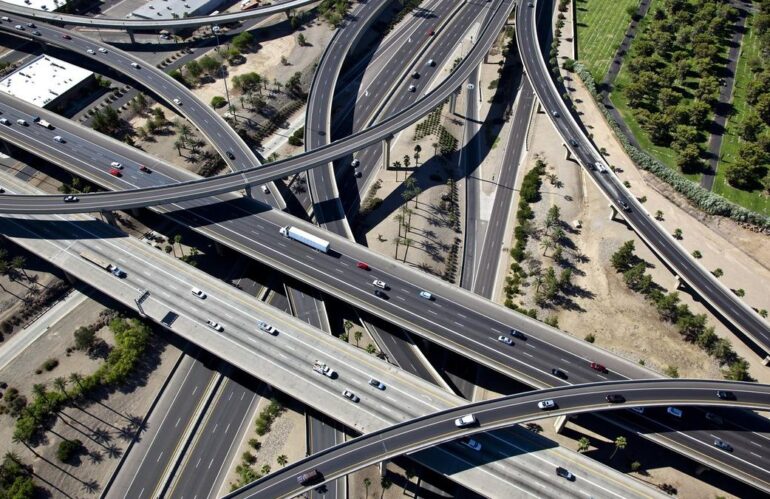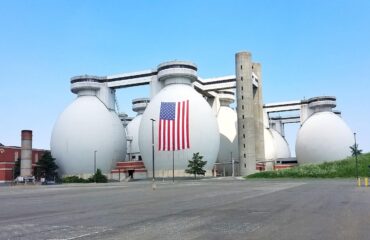America’s transportation system is the backbone of the nation’s economy and daily life, encompassing a vast network of roads, railways, airways, ports, and transit systems. More than just modes of travel, this infrastructure serves as the lifeblood of the country, enabling the seamless movement of goods, services, and people across vast distances.
From the interstate highway system that connects cities and towns to the railways that transport freight across the country, each component of the transportation network plays a crucial role in sustaining economic activity and fostering connectivity. Ports facilitate international trade, airports connect us to the global market, and transit systems provide vital links within urban areas.
Moreover, this infrastructure enhances the quality of life for millions of Americans by providing access to employment, education, healthcare, and recreational opportunities. Whether commuting to work, shipping goods to market, or traveling for leisure, the transportation system underpins virtually every aspect of modern society. In essence, America’s transportation infrastructure is not just a collection of roads and railways but a vital engine driving economic growth, innovation, and prosperity for the nation as a whole.
Challenges and Opportunities
America’s transportation infrastructure stands at a crossroads, presenting both challenges and opportunities for the nation’s future. With a vast network comprising approximately 4 million miles of roads, 117,000 miles of rail, 600,000 bridges, and numerous other critical components, much of this infrastructure was constructed decades ago and is now showing signs of wear and aging. Challenges such as traffic congestion, inadequate capacity, and reliance on outdated technologies loom large, threatening to impede the efficient movement of goods and people. These challenges impose significant costs on society, both in terms of economic productivity and quality of life.
However, amidst these challenges lie opportunities for renewal and revitalization. By investing in infrastructure repair, modernization, and innovation, the nation can not only address existing deficiencies but also pave the way for a more resilient, efficient, and sustainable transportation system that meets the needs of future generations.
Investing in the Future
Investments in transportation infrastructure have far-reaching benefits beyond addressing immediate repair needs. They serve as catalysts for job creation, economic growth, and enhanced quality of life. According to the U.S. Department of Transportation, every $1 billion in federal investment in transportation infrastructure creates an estimated 27,800 to 34,800 jobs, stimulating economic activity and supporting livelihoods across various sectors.
Furthermore, a modern transportation system fosters reliability, bolstering economic competitiveness and promoting environmental sustainability. By improving connectivity, reducing congestion, and enhancing efficiency, investments in transportation infrastructure lay the foundation for a more resilient and prosperous future for all Americans.
Aviation: Navigating the Skies
The aviation sector serves as a linchpin in America’s transportation landscape, facilitating the movement of people and goods both domestically and internationally. However, challenges such as air traffic delays, outdated air traffic control systems, and capacity constraints threaten to hinder the sector’s efficiency and safety.
To address these challenges, modernization efforts such as NextGen have been introduced to revolutionize the National Airspace System. NextGen aims to enhance the efficiency, capacity, and safety of air transportation by transitioning from ground-based to satellite-based air traffic management systems. By implementing NextGen technologies, we can streamline air traffic flow, reduce delays, and improve overall system performance.
Furthermore, NextGen holds the potential to reduce aviation’s environmental impact by optimizing flight routes, reducing fuel consumption, and minimizing emissions. As the demand for air travel continues to grow, investments in modernization efforts like NextGen are essential to ensuring the continued safety, efficiency, and sustainability of America’s aviation infrastructure.
Highways and Roadways: Building the Foundation
America’s highways and roadways form the backbone of the nation’s transportation network, enabling the seamless movement of goods and people across vast distances. However, inefficiencies, congestion, and deteriorating infrastructure pose significant challenges to the efficiency and reliability of our transportation system.
Smart investments in highway and road maintenance are not just about fixing what’s broken; they’re about taking proactive steps to ensure our roadways remain safe, functional, and efficient for the long haul. Here’s how prioritizing these investments and integrating innovative technologies can make a difference:
- Prioritizing Repairs and Upgrades: Regular maintenance and timely repairs prevent minor issues from becoming major problems. By focusing on the most critical areas first, such as bridges, tunnels, and major highways, we can ensure that the backbone of our transportation network remains robust;
- Preventative Maintenance Measures: Preventative maintenance, including resurfacing roads, clearing drainage systems, and inspecting infrastructure, can significantly extend the lifespan of roadways. This approach is cost-effective in the long run, as it helps avoid the need for more expensive, extensive repairs down the line;
- Intelligent Transportation Systems (ITS): ITS represent a leap forward in managing traffic flow and enhancing safety. By using sensors, cameras, and other technologies to gather real-time data, ITS can optimize traffic signals, provide timely information to drivers, and even predict and manage traffic patterns to reduce congestion;
- Improving Efficiency and Safety: The application of ITS technologies goes beyond just easing traffic congestion. It also plays a crucial role in improving road safety by alerting drivers to hazardous conditions, managing speed limits dynamically, and improving the response times of emergency services;
- Enhancing Traffic Flow: Through advanced traffic management systems, ITS can help ensure that traffic moves smoothly, reducing stop-and-go conditions that contribute to wear and tear on vehicles and road surfaces, as well as increasing fuel consumption and emissions;
- Environmental Benefits: By improving traffic flow and reducing congestion, we can also see environmental benefits. Smoother traffic means lower emissions and a smaller carbon footprint for our transportation network;
- Economic Impact: Efficient and well-maintained roads are vital for economic activity, enabling goods and services to move freely. Investing in highway and road maintenance can have a positive ripple effect on the economy by reducing transportation costs and improving accessibility for businesses and consumers alike.
By making strategic investments in highway and road maintenance and embracing cutting-edge technologies, we can build a safer, more resilient transportation network that meets the needs of travelers and businesses while promoting economic growth and prosperity.
Ports: Gateways to Global Commerce
Ports serve as critical gateways to international trade and commerce, playing a pivotal role in facilitating the movement of goods between nations. However, aging infrastructure and capacity constraints pose significant challenges to the efficiency and competitiveness of America’s ports.
Investments in port modernization and expansion are essential to addressing these challenges and ensuring the continued viability of our nation’s maritime infrastructure. By upgrading port facilities, dredging channels, and improving intermodal connections, we can accommodate growing cargo volumes and enhance the efficiency of goods movement.
Furthermore, investments in port infrastructure have far-reaching economic benefits, stimulating job creation, driving economic growth, and bolstering America’s position as a global trade leader. By prioritizing strategic investments in port modernization, we can strengthen our nation’s competitiveness in the global marketplace and pave the way for sustained economic prosperity.
Railways: Vital Components of America’s Transportation Network
Railways serve as vital arteries of America’s transportation system, playing a crucial role in the movement of freight and passengers across the country. However, the existing rail infrastructure faces significant challenges, including capacity constraints and aging infrastructure, which impede the efficient movement of goods and people.
Investments in freight rail infrastructure are essential to modernizing and expanding the capacity of the rail network. By upgrading tracks, bridges, and signaling systems, we can enhance the efficiency and reliability of freight transportation, reducing bottlenecks and delays. Additionally, investments in high-speed rail systems offer the potential to revolutionize passenger transportation, providing faster, more reliable alternatives to air and road travel.
High-speed rail systems have the capacity to significantly reduce travel times between major cities, alleviate congestion on highways and at airports, and promote economic development along rail corridors. By connecting urban centers with high-speed rail lines, we can foster regional integration, spur job creation, and enhance economic competitiveness on both a local and national scale.
Moreover, investments in rail infrastructure have the potential to generate substantial economic returns, creating jobs, stimulating economic growth, and enhancing overall productivity. By prioritizing strategic investments in rail transportation, we can build a more efficient, sustainable, and resilient transportation system that meets the needs of future generations while promoting economic prosperity and environmental sustainability.
Transit: Moving Communities Forward
Public transit systems play a critical role in providing affordable, accessible, and sustainable transportation options for millions of Americans. As urban areas continue to grow and roads reach capacity, the demand for transit services is expected to increase exponentially. In response to this growing demand, smart investments in transit infrastructure and technologies are essential to ensuring the continued viability and effectiveness of public transportation networks.
Investing in transit infrastructure not only expands access to transportation for underserved communities but also reduces congestion on roadways, mitigates environmental pollution, and promotes social equity. By providing viable alternatives to private vehicle travel, public transit helps alleviate traffic congestion, resulting in shorter commute times and increased productivity for both workers and businesses. Moreover, public transit plays a crucial role in reducing greenhouse gas emissions and combating climate change. By encouraging modal shifts from single-occupancy vehicles to buses, trains, and other forms of mass transit, investments in transit infrastructure contribute to a cleaner, more sustainable environment for future generations.
In addition to traditional transit systems, emerging technologies such as electric buses, autonomous vehicles, and mobility-as-a-service platforms offer promising opportunities to enhance the efficiency, accessibility, and sustainability of public transportation. By embracing innovation and strategic planning, communities can build resilient transit networks that meet the evolving needs of their residents while promoting economic prosperity and environmental stewardship.






